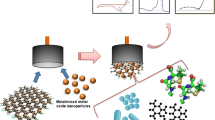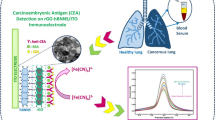Abstract
A novel method for fabrication of a diphtheria potentiometric immunosensor has been developed by means of self-assembling compound nanoparticles to a thiol-containing sol–gel network. A cleaned gold electrode was first immersed in a 3-mercaptopropyltrimethoxysilane (MPS) sol–gel solution to assemble a silica sol–gel monolayer. The silane entities were then polymerized into a two-dimensional sol–gel network (2D network) by dipping into aqueous NaOH. The second silane layer was formed by re-immersion in the MPS sol–gel solution overnight. The compound nanoparticles (nanocompounds) containing gold nanoparticles and silver nanoparticles were then chemisorbed on to the thiol groups of the second silane layer. Finally, diphtheria antibody (anti-Diph) was adsorbed on to the surface of the compound nanoparticles. The modified process was characterized by cyclic voltammetry (CV). Detection is based on the change in the potentiometric response before and after the antigen–antibody reaction. A direct potentiometric response to diphtheria antigen (Diph) was obtained from the immobilized diphtheria antibody. The potentiometric response of the resulting immunosensor was rapid and the linear range was from 22 to 800 ng mL−1 with the linear regression equation ΔE=−79.5+69.4 log [Diph] and a detection limit of 3.7 ng mL−1 (at 3δ). Up to 19 successive assay cycles with retention of sensitivity were achieved for probes regenerated with 0.2 mol L−1 glycine–hydrochloric acid (Gly–HCl) buffer solution. Moreover, analytical results from several serum samples obtained using the developed technique were in satisfactory agreement with those given by the ELISA method, implying a promising alternative approach for detecting diphtheria antigen in clinical diagnosis.






Similar content being viewed by others
References
Heineman WR, Halsall HB (1985) Anal Chem 57:1321A-1331A
Hage DS (1999) Anal Chem 71:294R-304R
Wang J (1999) Anal Chem 71:328R-332R
Rickert J, Gopel W, Beck WB, Jung G, Heiduschka P (1996) Biosens Bioelectron 11:757–768
Jean-Louis B, Daniel T (1984) Anal Chim Acta 163:309–313
Solgelsky RL, Rechnitz GA (1981) Anal Chim Acta 123:135–141
Kricka LJ (eds) (1995) Clinical and biochemical analysis, vol 17. Marcel Dekker, New York, pp 77
Xiao Y, Ju HX, Chen HY (1999) Anal Chim Acta 391:73–82
Tang FQ, Meng XW, Chen D, Ran JG, Gou L, Zhen CQ (2000) Sci China B 30:119–124
Liu ZJ, Deng JQ, Li D (2000) Anal Chim Acta 407:87–96
Willner I, Katz B (2000) Angew Chem Int Ed 39:1180–1183
Ulman A (1991) An introduction to ultrathin organic films from Langmuir–Blodgett to self-assembly. Academic Press, New York
Xiao Y, Ju HX, Chen HY (2000) Anal Biochem 278:22–28
Walcarius A (2001) Electroanalysis 13:207–213
Bharathi S, Nogami M, Ikeda S (2001) Langmuir 17:1–4
Michaels AM, Nirmal M, Brus LE (1999) J Am Chem Soc 121:9932–9939
Frens G (1973) Nat Phys Sci 241:20–22
Robertson JW, Cai M, Pemberton JE (2001) Adv Mater 13:662–671
Cai M, Ho M, Pemberton JE (2000) Langmuir 16:3446–3453
Martin CR, Mitchell DT (1998) Anal Chem 70:322A-327A
Zhao JG, Henkens RW, Stonehuerner JL, O’Daly JP, Crumbliss AL (1992) J Electroanal Chem 327:109–119
Horisberger M, Rosset J, Histochem J (1977) Cytochem 25:295–305
Ebato H, Gentry CA, Herton JN, Muller W, Okahata Y, Ringsdorf H, Suci PA (1994) Anal Chem 66:1683–1689
Okahata Y, Kawase M, Niilura K, Ohtake F, Furusawa H, Ebara Y (1998) Anal Chem 70:1288–1296
Acknowledgements
Financial support of this work was provided by the National Natural Science Foundation of China (29705001), the Chinese Education Ministry Foundation for excellent young teachers, and the Natural Science Foundation of Chongqing City, China.
Author information
Authors and Affiliations
Corresponding author
Rights and permissions
About this article
Cite this article
Tang, D., Yuan, R., Chai, Y. et al. Novel potentiometric immunosensor for determination of diphtheria antigen based on compound nanoparticles and bilayer two-dimensional sol–gel as matrices. Anal Bioanal Chem 381, 674–680 (2005). https://doi.org/10.1007/s00216-004-2916-3
Received:
Revised:
Accepted:
Published:
Issue Date:
DOI: https://doi.org/10.1007/s00216-004-2916-3




